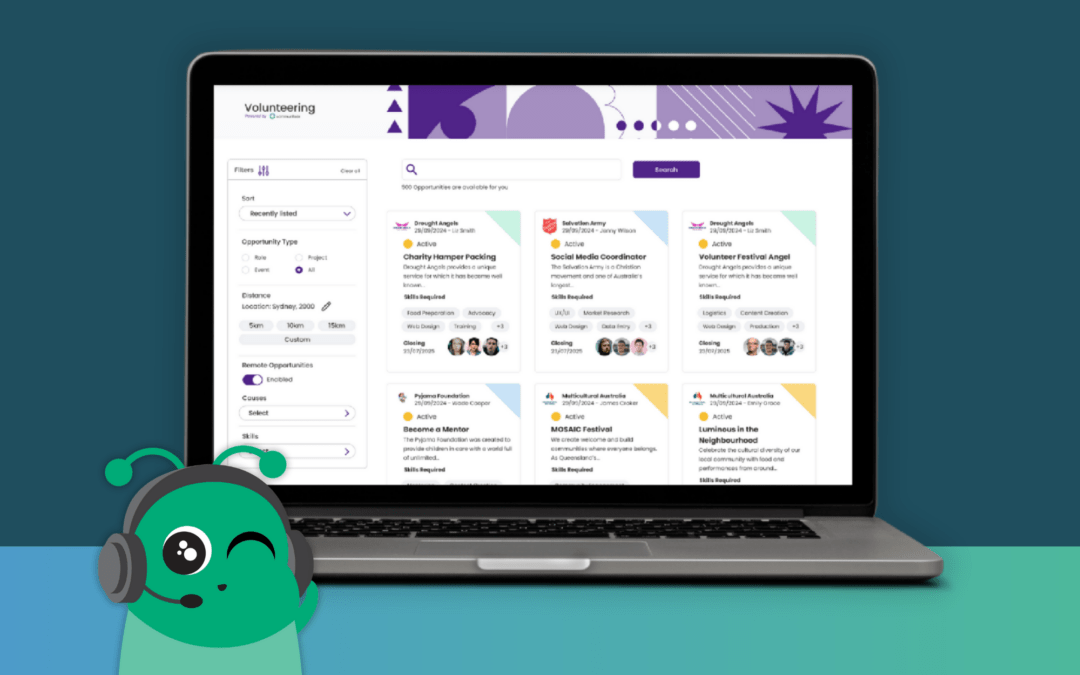Without employees, an organisation wouldn’t exist. And without employee engagement and motivation, an organisation would not be able to thrive.
Engaged employees can have a positive impact on the company’s financial performance. They are more productive, efficient, and motivated, which can lead to increased revenue and profits. But this is because they are motivated to do their best and are committed to achieving the company’s goals.
Effective volunteering programs leave employees feeling empowered and create high levels of pride in their work, their organisation and its impact on the wider community. This is why volunteering is becoming a crucial part of any employee engagement strategy.
Research has shown that there is a link between volunteerism and employee productivity. The feeling of making a difference in the world cultivates a sense of purpose that brings employees fulfilment, resulting in a higher level of commitment and workplace engagement.
So, why are conversations around employee engagement becoming more frequent all of a sudden?
Changing Workforce Dynamics
The rise of the millennial workforce has brought about a shift in expectations and values, with a focus on work-life balance, purpose-driven work, and employee well-being. This has led to an increased emphasis on creating an engaged and supportive work environment.
Competition for Talent
The war for talent has intensified as companies compete to attract and retain top talent. To remain competitive, companies are investing in employee engagement initiatives to create a workplace culture that is attractive to potential employees.
Rise of Employee Voice
Social media and online review sites have given employees a platform to share their opinions and experiences, which can have a significant impact on a company’s reputation and ability to attract and retain talent. As a result, companies are recognising the importance of listening to and addressing employee concerns to create a positive and engaged work environment.
Here are 10 ways to help you increase employee engagement
1. Challenge your employees.
Professional development opportunities can provide a sense of purpose and direction. When employees feel that they are growing and developing, they are more likely to feel engaged and invested in their work. Companies that invest in their employees’ development are more likely to attract top talent and retain high-performing employees.
Additionally, challenged employees benefit organisations. They can use their newly gained skills and knowledge in their work to benefit the organisation. Moreover, if employees can gain new skills and knowledge in their organisation, they would be less likely to look for work elsewhere. It’s a win-win situation for all.
This could include implementing a mentoring program, or even fitness challenges. The drive it takes to challenge oneself, even activities facilitated unrelated to work can benefit staff engagement.
2. Have regular conversations around career progressions.

Employees want new challenges and opportunities to stay engaged in their work, grow their skills, and advance in their careers. A Pulse Study from AHRI found that a key reason employees remain in a company is opportunities for career progression.
Conversations around career progressions should be front and centre. It also shows that you care about your employees.
Volunteering can help employees develop new skills and gain valuable experience that can enhance their job performance. For example, volunteering in a leadership role can help develop skills such as project management, team building, and communication. And bringing this volunteering within official career progression programs can only further increase employee engagement in their own success.
3. Invest in your employees.
We all know the survey results; most people are not happy at work.
The best-performing businesses place learning at the centre of their employee experience. They provide opportunities for individualised development and close the gap between what employees are offered and what they actually need. Firstly, this continuous growth and improvement would make employees more motivated. Secondly, also more equipped, and engaged to take on new challenges within the role and organisation.
Investing in your teams also puts out the good word in the marketplace helping you attract the best talent.
Through employee volunteering, teams can learn and develop a new skill set outside of the workplace. Employee volunteering provides individuals with skill-building opportunities, including leadership and learning opportunities. It allows employees to grow, enhances their communication and collaboration skills, and gives them a fresh perspective. Learning a new skill is a great morale booster and can positively affect workplace engagement.
4. Encourage flexible working.
Back in 2016, a report by Morgan McKinley on Flexible Work Practices found that in Australia, 94% of employees felt the option to work flexibly helps attract and retain talent. In COVID times, flexible work has become more relevant than ever.
Employees are increasingly looking for the perfect balance between work and life. Younger workers have grown up with technology, and they are comfortable working remotely and using digital tools to collaborate with colleagues. As technology has made remote work more accessible and efficient, younger workers in particular are more likely to seek out flexible working arrangements.
Flexible working can also help ensure business continuity in case of unforeseen events such as technological issues, inconvenient weather or other disruptions. Having a flexible work policy can allow employees to work remotely and continue to deliver results even when they are unable to come into the office. While also feeling like they’re in a safer and familiar environment.
By allowing and encouraging flexible work options, you help to foster a friendly work environment and drive a more positive attitude. Which in turn increases employee engagement, productivity and retention.
5. Emphasise meaningful work.
Connecting the work of employees to the external impact of the company can also help align their goals with the company’s goals. Engaged employees who are doing meaningful work have a clear understanding of how they contribute to the company’s mission, purpose and strategic objectives.
Employees may be more likely to come up with new ideas and solutions that can help the company achieve its goals and have a positive impact on the world. This is why for employee engagement it’s so important to communicate the meaning and also put the right people in the right role.
Connect purpose to your business day to day, and the daily contribution of your employee. How are your staff contributing to your overall sustainability targets? What are the outcomes of your charitable activities employees have been involved in?
6. Model your core values and emphasise your mission.
Companies should clearly communicate their mission and values to employees. Employee engagement flourishes when teams know there’s a goal they understand and a purpose to inspire them. Your core values and mission statement are the foundation of your company culture, which affects your employee engagement.
Start by creating a concise list of company core values, then train each employee in these values. Doing so will guarantee employees understand the importance of the company’s values, how they positively impact the business, and what is expected of them. And also identify which of their personal values align with the business, forming a deeper connection to their work.
Businesses are no longer responsible only for the economic growth in their communities, they are also the drivers of social change. Based on the evidence, the corporate volunteering benefits show a significant impact on engagement and create a positive upward spiral. Businesses that do not invest and give back to society risk falling behind competitors with a strong CSR strategy.
7. Check in often.
Gone are the days of simply relying on six-month reviews for providing feedback. Today’s workforce craves regular feedback, which then leads to faster correction if necessary. This is especially relevant in the time of COVID, when employees are potentially feeling disengaged from the traditional face-to-face work environment.
Checking in with employees about their well-being during regular meetings requires a compassionate and supportive approach. By actively listening to employees, providing support, and following up on concerns, managers can help create a positive and healthy work environment that supports employee well-being and engagement.
Create virtual rooms where employees can pop in and out of to feel the presence of others, set up virtual games nights to add social elements to the week, or even make sharing in meetings commonplace to form support networks.
8. Prioritise physical and mental health.
The employee value proposition is fundamentally changing. According to a Deloitte survey, 90% of employees now say their physical and mental well-being is just as important as their pay.
A company-wide wellness initiative is a great way to improve employee engagement. We all know about taking sick days, but companies are increasingly encouraging employees to take mental health days when they need to step away from work to focus on themselves.
This comes especially from the top down. While this may be in some policies, truely allowing your employees to feel they can utilise these options is the key to success, and uptake will reduce over time with greater wellbeing.
Employee volunteering is a great tool to promote a healthy work-life balance and foster a culture that supports employee wellbeing. Three-quarters of adults reported that volunteering makes them feel physically and emotionally healthier. This means employees feel less burnt out. It decreases absenteeism and improving mental health.
9. Conduct employee engagement surveys regularly.
Employee surveys provide a platform for employees to share their feedback and opinions on various aspects of their work environment, including job satisfaction, work-life balance, communication, and recognition. Surveys can help to improve communication and transparency between management and employees by providing a means for employees to express their concerns and giving management insights into employee perceptions.
Not only will regular employee engagement surveys help you understand what’s working and what needs to be improved, they will also make your employees feel valued. Employee feedback is essential to successfully engage your workforce, so it’s a win-win situation once again!
Allowing your employees to have input in what activities you provide for any of the tips on our list will do wonders for engagement. What interests do your teams have? How can these flow across departments? What access or time constraints do we need to work with so everyone feels included?
10. Coordinate volunteering opportunities.
You know we needed to include this one!
Employees want to know they work for a company that cares about making a positive contribution to society, and volunteering is perfect for that! It unites employees toward a larger purpose, whilst offering an opportunity to connect on a deeper level.
A survey by Deloitte revealed nine out of ten employees think that company-sponsored volunteer activities—such as 10k runs or food drives help create a better working environment. A positive corporate culture where employers support their staff and encourage them to volunteer will increase employee productivity and satisfaction.
That’s what our role at Communiteer is – to connect corporate employees with not-for-profit organisations that might need their skills.
Not only do we need to provide our employees with ways they can contribute, but also the opportunities that align with their personal values, the skills they have to contribute or perhaps the new skills and activities they’ve been wanting to try out for awhile.
Compared to before the pandemic (Source: Allison+Partners):
- 84% feel more empowered to use their work for good.
- 60% view professional development as more important.
Businesses play an integral role in building a thriving community. They carry a social responsibility to leave a positive impact. Companies can encourage employees by allowing paid time off for volunteering, offering other incentives and rewards, or introducing policies that support employee volunteering. For example, voluntary-time-off (VTO) policies define how much time employees get to volunteer during work hours and how they can use that time.
Check out Communiteer’s Hack4Good in 2022 with Pfizer Pharmaceuticals Australia!
This event engaged 24 employees for a total of 96 hours, directing skills towards 4 community partners.
Kickstart your corporate volunteering strategy!
Inspire creativity, problem-solving and compassion in your teams while supporting NFPs to sustain and scale their impact on social causes. Through our expert consultation and advisory process, we craft the ideal solution to achieve business outcomes and extend the possibilities far past investment.
Corporate volunteering in Sydney, Melbourne and other major cities is reigniting with online and event-based opportunities. Find a volunteer team-building activity that suits your team!
Reach out to our team below:




